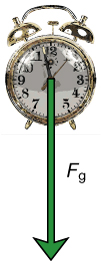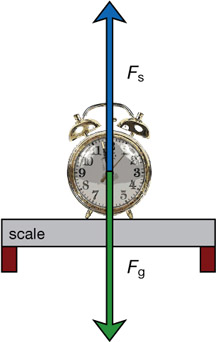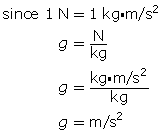Module 4—Gravitational Force
 Read
Read
Read “Describing Gravitational Force as a Field” on pages 200 and 201 in your physics textbook to reinforce what you learned from your work in the previous simulation.
 Try This
Try This
You hear the terms mass and weight incorrectly used as synonyms for each other. Enhance your understanding of the differences between them in the following activity.
 Module 4: Lesson 1 Assignment
Module 4: Lesson 1 Assignment
Remember to submit the answer to TR 4 to your teacher as part of your Module 4: Lesson 1 Assignment.
TR 4. Complete “4-2 QuickLab: Relating Mass and Weight” on page 198 in your textbook. Obtain the needed materials from your teacher. Be sure to zero the spring scale in the upright position before you start to take measurements. Let mass (in kg) be the manipulated variable, and plot it on the horizontal axis of your graph.
The Concept of Weight and the Force Due to Gravity
The terms weight, mass, and acceleration due to gravity are all related but are often misused. A common example of this is a weigh scale, which is really a device designed to report an object’s mass in kilograms, not its weight in newtons. Without weight, however, a scale won’t work. So what is the relationship? An application of Newton’s second law and some free-body analysis will reveal the connections between mass and weight. You can review free-body diagrams in Lessons 4 and 5 of Module 3.
Suppose you knock your alarm clock off the night stand when the alarm starts buzzing. The clock would fall under the influence of gravity. Without considering air resistance, the following free-body diagram describes the forces acting on the clock.
According to Newton’s law, the net force acting on the clock is


© 2007 Jupiterimages Corporation
Since the clock is accelerating due to gravity, then a = g, where g = –9.81 m/s2 at Earth’s surface. Thus, the equation becomes
![]()
- The gravitational force that acts on the clock is
 and represents its weight.
and represents its weight.  may also be written as
may also be written as  to represent weight (
to represent weight ( ).
). - The mass of the clock is represented by m, and
 is the acceleration due to gravity (always pointing down).
is the acceleration due to gravity (always pointing down).
If the clock were placed on a scale, the springs in the scale would produce an upward force on the clock equal in magnitude to its weight ![]() . Therefore, the spring scale actually measures the object’s weight, not its mass. However, the mass may be displayed by simply dividing out the acceleration due to gravity, which can be done electronically on a digital scale or by adjusting the numbers on a rotating display dial.
. Therefore, the spring scale actually measures the object’s weight, not its mass. However, the mass may be displayed by simply dividing out the acceleration due to gravity, which can be done electronically on a digital scale or by adjusting the numbers on a rotating display dial.


© 2007 Jupiterimages Corporation
It should be noted that the mass of an object does not change even if its weight changes as a result of moving it away from the surface of Earth (or any other mass in the universe). In addition, the units for the acceleration due to gravity can be reported in one of two ways.
Method 1

Method 2

 Read
Read
Read “The Concept of Weight” on pages 197 to 199 in your physics textbook.
 Self-Check
Self-Check
SC 1. Complete the “Concept Check” question on page 197 in your physics textbook.
SC 2. Complete the “Concept Check” question on page 201 in your physics textbook.
 Self-Check Answers
Self-Check Answers
SC 1.
Diagram (b) best represents the gravitational forces because it not only shows attraction, it also shows the equal and opposite forces predicted by Newton’s third law.
SC 2.
(a) The gravitational field strength will be increased by a factor or 16 because it is inversely proportional to the radius.
(b) The gravitational field strength will be 1/4 of its original value.
(c) The gravitational field strength remains the same because both m and Fg are doubled, so the ratio remains the same.
(d) The gravitational field strength remains the same because both m and Fg are halved, so the ratio remains the same.